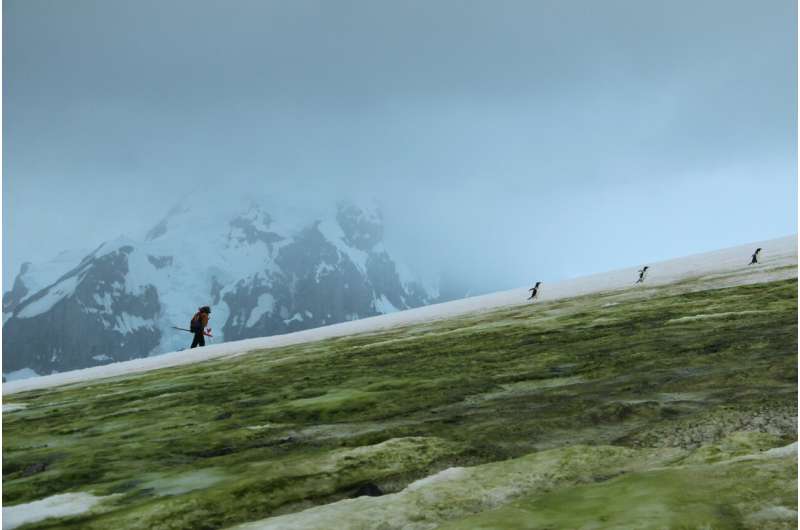
A tiny seed is stuck between loose gravel and coarse sand. There is nothing else alive around it. All it can see is a wall of ice reaching 20 meters up into the sky. It is cold. Survival is hard around here. In winter, it is dark even during the day. In summer, the sun bakes the ground hard and dry for 24 hours.
The seed was left here by tourists several years ago, who came to see the wonders of the last remaining wilderness on planet Earth: Antarctica.
Life is changing. Warmer temperatures are melting the glaciers and the meltwater allows the seed to start growing. Antarctica is in the grip of some of the world’s fastest climate change. Its melting ice could contribute up to 5 meters of sea-level rise. Where the ice disappears, it leaves barren ground behind. By the end of this century, a small country’s-worth of land could appear from below the ice.
New land in Antarctica is colonized by pioneer organisms. The first to appear are algae and cyanobacteria—minuscule organisms tiny enough to fit between sand grains. Here, sheltered from the burning sun’s rays, the algae live and die and, as they normally do, slowly stick the sand particles together to create a surface for other organisms to grow on.
Lichens and mosses follow. They are just a few centimeters tall but compared to other life on Antarctica’s shores they look like giants. Once lichens and mosses have made themselves a home, even larger organisms may show up and eventually the plants take hold. Their seeds, if stuck in a soft and moist mossy cushion, proliferate and grow.
Only two plant species are native to Antarctica. Both spread their seeds by wind. This makes them independent from animals and insects, which aren’t needed to carry the pollen or seed to another flower or fresh patch of soil. The wind just blows them there. All these plants need is that bit of moss or lichen to hold on to, so they are not blown away into the cold desert of snow and ice.
But this natural sequence of plant establishment has been broken, as the climate changes and conditions become more habitable. More than 100 plant species have invaded Antarctica already. The newcomers are doing well. For instance, the fast-growing opportunist Poa annua, the common lawn grass, has rapidly spread across the sub-Antarctic Islands from South Georgia to Livingston Island and is now making its way south to the Antarctic Peninsula.
Researchers are wondering how much potential there is for new plant species to thrive in Antarctic soils. What will Antarctica look like in 100 years’ time? Could it be green like the tundra landscapes we know from the Arctic?
A new map
I’m part of a group of scientists who have just combined satellite data with field measurements to produce the first map of green vegetation across the whole Antarctic continent.
We detected 44.2 km² of vegetation in total, mostly found in the Antarctic Peninsula and neighboring offshore islands. This vegetation area makes up just 0.12% of Antarctica’s total ice-free area, highlighting that Antarctica remains the frozen continent dominated by snow and ice. For now.
An unspoiled Antarctic environment is worth protecting for its own good, but it also serves humanity. Climate and weather patterns across the world are driven by the immense large ice masses on the Antarctic continent. Their disappearance would change our planet as we know it.
My colleague Charlotte Walshaw from the University of Edinburgh was the lead scientist of the recent research mapping vegetation in Antarctica. She points out that these new maps provide key information on a scale which couldn’t be achieved in the past. “We can use these maps,” she told me, “to keep a very close eye on any large-scale change in vegetation distribution patterns.”
Vegetation in Antarctica encounters the harshest living conditions on the planet. Only the most resilient organisms can thrive there, and we don’t know yet what their future holds with climate change. Now that we know where to look for these plants, we can provide more accurate conservation measures to safeguard their future.
This article is republished from The Conversation under a Creative Commons license. Read the original article.![]()
Citation:
First map of vegetation across Antarctica reveals a battle for the continent’s changing landscape (2024, August 9)
retrieved 9 August 2024
from https://phys.org/news/2024-08-vegetation-antarctica-reveals-continent-landscape.html
This document is subject to copyright. Apart from any fair dealing for the purpose of private study or research, no
part may be reproduced without the written permission. The content is provided for information purposes only.







